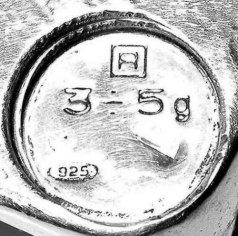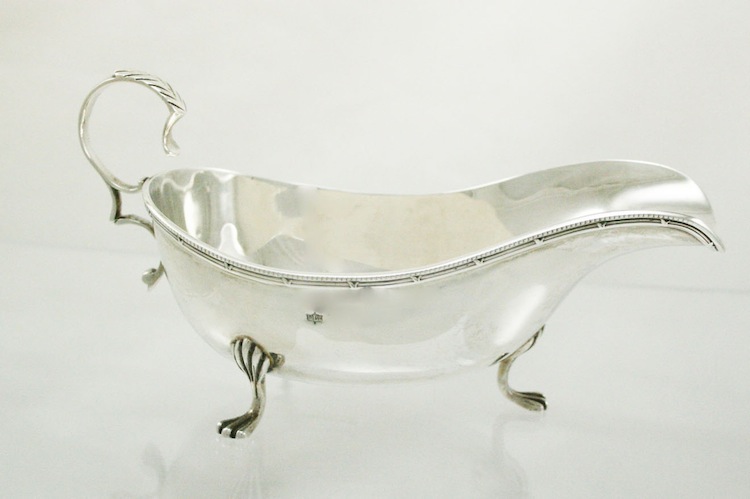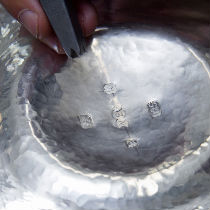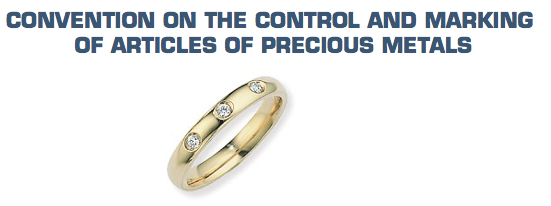Italy
1 ~ From 1872 – rarely used (an .800 stamp is more common)
2 ~ Fascist period 1934 – 1944
3 ~ 1944 to 1968
4 ~ 1968 to Present
In the last three examples, the number would be registered to an individual maker, the initials represent the region (ie. FI = Firenze)

This is a brief history and a selection of Italian silver hallmarks from 1870 to present days. The documentation about this period of Italian silversmithing is extremely scarce and difficult to find.
The objective of this page is to offer an introduction to this matter and a cue for a more deep study of this fascinating period. In 1870, with the conquest of Rome and the end of Stato Pontificio (Papal State), Italy attained its unity and an unique system of hallmarking was introduced in the Regno d’Italia (Kingdom of Italy). The law 2 May 1872 deregulated silver production and introduced only a facultative inspection of silver artifacts.
|
1 |
|
facultative hallmark, purity degree 950/1000 |
|
2 |
|
facultative hallmark, purity degree 900/1000 |
|
3 |
|
facultative hallmark, purity degree 800/1000 |
Usually silver pieces were marked only with the ‘800’ (purity degree 800/1000), sometimes coupled with the silversmith’s hallmark.
The ‘800’ was an unofficial mark and there was no uniformity in its shape.
|
4 |
|
‘800‘ with oval outline and VM (presumably silversmith’s initials) |
|
5 |
|
‘800‘ without outline |
|
6 |
|
‘800‘ without outline coupled to silversmith’s hallmark |
|
7 |
|
‘800‘ without outline |
The law 5 February 1934 n. 305 introduced uniformity in the shape of silversmith’s marks.
The new mark identifying the silversmith consisted of a lozenge containing number corresponding to the number identifying the silversmith ‘fascio’: fascist party symbol two letters: initials of the Province
The lozenge was coupled to an oval containing the purity degree 800 or 925 per thousand.
official marks (legge 5 Febbraio 1934 n. 305)
|
8
|
 |
‘800’ and lozenge mark identifying the silversmith
number / fascio / province |
|
9
|
 |
lozenge with ‘fascio’
|
|
10
|
 |
purity degree ‘800 into an oval outline
|
The Law 26 October 1944 n. 313 (Decreto Legislativo Luogotenenziale 26 Ottobre 1944 n. 313) ordered the elimination of the ‘fascio’ (symbol of ‘fascism’) maintaining into the lozenge only the number (identification of the silversmith) and the two letters (initials of the Province).
The availability of new lozenges was not immediate and for a short period the old marks with the obliterated ‘fascio’ were maintained. I believe that in the period 1944/1946, before the new hallmarks were available, also temporary and not official marks were used.
official mark (Decreto Legislativo 26 Ottobre 1944 n. 313)
|
11
|
 |
lozenge mark without ‘fascio’
number / province |
|
12
|
 |
temporary unofficial mark. Presumably PROV signifies PROVVISORIO (TEMPORARY)
|
The Laws 30 January 1968 (Legge 30 gennaio 1968 n. 46) and 30 December 1970 n. 1496 (D.P.R. 30 Dicembre 1970 n. 1496) introduced new hallmarks for silver and precious metals. The mark was modified to a polygogonal shape and a star was added on the left. Numbers and Province letter were maintained.
Purity degree 925, 835 and 800 per thousand were allowed and inscribed into an oval outlined mark. This system is still in use in present days.
official marks (Legge 30 Gennaio 1968 n. 46 and D.P.R. 30 Dicembre 1970 n. 1496 )
|
13
|
  |
polygon with ‘star’
star / number / province |
|
14
|
   |
purity degree into an oval outline
‘800’ ‘925’ |
The ‘Decreto Legislativo 22 Maggio 1999, n. 251’ introduced a system of marks for objects made in precious metals and weighted with resin or mastic . The new mark is a R inside a square outline (the R is the abbreviation of ‘Riempito’ = filled in English).
Official marks (Decreto Legislativo 22 Maggio 1999, n. 251)
|
15
|
This piece was created in a resin or mastic then covered with 3 to 5 grams of 925 standard silver as shown by 3 ÷ 5
|
a) In the objects partially or totally coated with a sheet of precious metal, the use of putty is allowed to fix the thin sheet to its support, on condition that the density of the putty is not more than 2,5 g/cubic cm. and that its percentage in weight does not exceed 25% of the total weight of the object, and that it is marked with an “R” in a square accompanied by the metal’s weight in grams and tenths of gram, followed by the symbol “g” for the coverings in platinum, palladio and gold, and adheres to the conditions illustrated at letter c) for the coverings in silver;
b) In the feet or bases of pots, candelabra, cups and similar objects weighted or strengthened, is admitted the use of a metallic filling up, on condition that this is applied in manner to be able to be dismantled and fully visible or, if covered with metallic or non metallic lids, such covering is fixed so as to be easily dismantled. Every part of non precious metal, included the covering lids, will be marked with the generic indication “metal” or the specific name of the metal or of the league used. When the covering is in precious metal it is marked with its specific mark, the title, the word riempito (filled) and its weight in grams followed from the letter “g”;
c) In the handles of the knives not metallic substance is allowed without limits of its density, and is allowed to fix the blade with welding in non-precious metal on condition that the handle bears the word “riempito” or the mark “R” within a square and the indication of the weight of the precious metal (in grams and tenths of gram) followed by the symbol “g”. In the silver handles with a weight of precious metal inferior or equal to 50 grams the weight may be expressed in approximate manner, using the “R” followed by two figures, separated from the symbol “÷” and the letter “g”, in which the figures represent, in grams, the minimum and maximum weight of the precious metal: 1÷2, 2÷3, 3÷5, 5÷7, 7÷10, 10÷13, 13÷16, 16÷20, 20÷25, 25÷30, 30÷35, 35÷40, 40÷45, 45÷50.




















